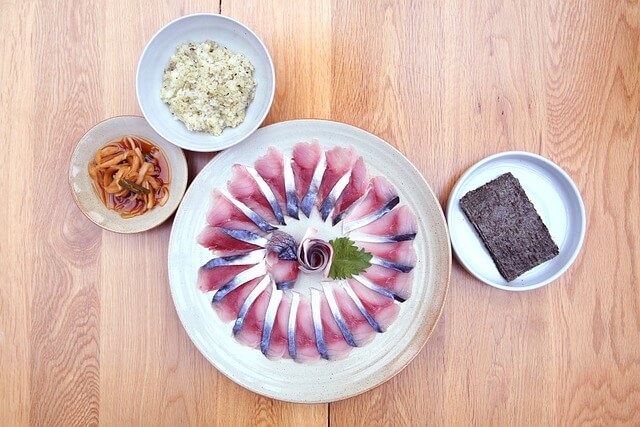Learning to roll sushi can be a little tricky at first. And there you have a wrapper to hold in the rice. But since there’s no seafood wrapper in a sushi pizza, how will it stick together?
Successful sushi pizza requires that you select the correct rice and prepare it so that it is sticky without being gummy. You can choose from several crust types, a variety of sauces, and whatever toppings you want. Because it is a fusion dish, sushi pizza has many possibilities.
Sushi is a Japanese dish, and pizza was born in Italy. How about sushi pizza—it seems like something born in California. However, this fusion dish was created north of the border in Canada. If you can use a spatula, you can successfully make sushi pizza.
Use Short-Grain Sushi Rice
As you scour the net for sushi recipes, it is not hard to come across recipes that claim you can make sushi with regular white rice, jasmine, even brown rice. Since the seaweed wrapper holds the ingredients together, it is possible to use alternative rice. However, with this dish, you must use genuine sushi rice. Here’s why.
Sushi rice, known as sushi meshi in Japanese or japonica in English, is necessary for making sushi. It is short-grain rice known for being sticky without being gummy. Long grain rice, such as Jasmine and Basmati, become hard when they cool, and these kinds of rice also do not stick together well in part because their texture is dry and fluffy.
As you look for sushi rice, ideally, you want the short-grained. Some rice labeled as Japanese is a Calrose variety, medium-grain rice. You can use it for sushi, but the short-grained japonica is ideal.
Not all rice labeled sushi is short-grained. For example, this Kokuho Rice is labeled as sushi rice, but it is medium-grained rice. But this Lundberg California Sushi Rice is short-grained. Take time to read the label, especially for any sushi recipe where you won’t use seaweed to hold the dish together.
Make the Sushi Rice Correctly
When you prepare rice for this dish, do not take shortcuts.
- When you wash the rice, rinse it thoroughly to remove extra bran and starch. A sieve with small holes is an excellent way to wash the rice.
- Next, soak the rice in cold water for 30 minutes so the rice will rehydrate.
- Drain this water. It should be clear.
- When you get ready to cook the rice, use slightly less water than you usually use. This will keep the rice from getting mushy when you add sushi vinegar.
- After you steam the rice, cool it in a large container so you can spread out the rice. Doing so helps evaporate moisture to keep it from becoming soggy.
Make and Add the Sushi Vinegar
Hopefully, as the rice was steaming, you made the sushi vinegar.
Whisk the following:
- ½ cup of rice vinegar
- 2 tbsp. sugar
- 1 tbsp. salt
Tip: If the sugar doesn’t dissolve, microwave the vinegar for 15-20 seconds.
Most bottles of vinegar labeled as “sushi” contain other ingredients, including corn syrup and msg. On the other hand, some labeled seasoned, such as this Kikkoman Seasoned Rice Vinegar, only have rice vinegar, sugar, and salt. (Water is added to bring the acidity to 4.1 pH, necessary to keep rice that’s left out for several hours from going bad.)
Check the Rice
Your rice, after it is steamed, should be firm without having a crunchy core. It also should be sticky and keep its shape.
Cool the Rice
Use a spatula or wooden spoon or a shamoji to combine, not stir the rice. Do this by folding the rice. The grains should be separated without being broken or mashed together while
While stirring the rice, fan it to remove excess water. When your rice is fluffy, not wet or slippery, it is done. Cover the rice with a damp towel until you need it.
Make Your “Sauce” and Toppings
Most recipes for sushi pizza call for a wasabi aioli to spread either under the toppings or on them. There are probably as many ways to make a wasabi aioli as there are sushi chefs, but this is a simple, mild version.
Whisk an egg yolk with the following:
- 1 tsp Dijon mustard
- 2 tsp wasabi powder
- 2 tbsp rice vinegar
- 1 cup canola oil
This version will have a slightly dairy flavor:
- 2 tbsp mayonnaise
- 2 tbsp milk
- 1 tbsp wasabi powder
Another popular option is to combine mayo and Sriracha—proportions are up to how spicy you want your sauce to be. Still, a typical ratio is 2 tbsp mayo to 2 tsp Sriracha.
Or use a premade sauce, such as Kikkoman’s Wasabi Sauce, with wasabi and horseradish for an extra kick.
During this time, prep your toppings. Again, be as creative or traditional as you want. Keep in mind that you will be slicing your pizza as you plan them. Thinly sliced and small are best.
Many chefs prefer to include salmon, avocado, and green onions as their toppings, and black sesame seeds sprinkled on top. Consider using crab meat or kelp, or fish roe as a caviar topping for the mini pizzas.
Whether you spread the sauce on the crust or over the toppings is up to you. Many chefs prefer to put the sauce on the toppings, using it more as a condiment.
Decide What Kind of “Crust” You Will Make
When making pizza, you have several crust choices—deep-dish, thin-crust, and others. The same is true for your sushi pizza. Your skill level, comfort zone, and how true you want to be to the spirit of sushi will help you decide what you want.
- Panko style—easy, but sushi purists look down on it
- Fried—the hardest but should keep purists happy
- Mini—easiest of all and should make everyone happy
Panko Version
A panko version is the least sushi-like dough but is also easier than a fried version.
This crust will require a 6-8-inch round pan, three large plates, as well as an 8 to 10-inch frying pan.
- Put plastic wrap in the round pan.
- Pack the rice in firmly.
- To harden the crust, chill the rice.
- Whip up an egg and water mixture.
- Once the crust has been chilled, coat the rice patty in flour.
- Dip the crust in the egg and water mixture so the panko will stick to the patty.
- Fry the patty on both sides. The result should be golden brown and crispy.
The panko helps the patty stick together as you flip it, which is why it is preferred by many. However, the panko version is the least sushi-like. This leads us to the fried version.
Fried Version
The fried version requires that you use a cheesecake form. It’s the only pan needed since you will not be dipping the crust.
- Press the rice firmly into the form, about an inch deep. Unlike with the panko crust, do not use plastic wrap.
- Remove the side from the cheesecake form and use a large knife or spatula to slide the dough onto a smooth cutting board. If needed, firm the dough patty.
- Pour oil into a frying pan and heat it. When the oil is warm, slide the patty into the pan. Again, you might need to fix the patty—do so in the pan.
- Get a plate larger than the frying pan. When the patty is browned on one side, put the plate on the pan, and flip it over. This eliminates (hopefully) the patty from breaking.
- Add some additional oil to the pan, warm it, and then slide the patty back into the pan. Once the other side is brown, slide it onto a pizza plate and prepare to add the toppings.
To watch a chef use this advanced technique, check out the video:
Mini Pizza
The advantage of mini-pizzas is that you can make panko, fried, or even make traditional, uncooked sushi pizza crusts.
Follow the same process above if making a panko dough.
- If making a fried dough, divide your dough into four balls and flatten each ball 4 to 5 inches wide. Then fry until lightly brown.
- For an uncooked pizza, divide the dough, shape into balls, and then flatten and place onto your serving plate.
Bottom Line
Don’t think of making a sushi pizza as a challenge. Instead, consider it an opportunity to be creative. Ensure that your rice turns it sticky but not mushy, pick your crust, and add your toppings. Follow these steps, and you’re guaranteed to have a delicious sushi pizza pie.



